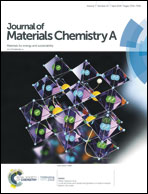Bifunctional NiCo2S4 catalysts supported on a carbon textile interlayer for ultra-stable Li–S battery†
Abstract
Lithium–sulfur (Li–S) batteries with high energy density and natural abundance are critical to achieve the low-cost and large-scale energy storage applications. Suffering from the sluggish redox kinetics together with the accumulated intermediate Li2Sx (x = 4–8) polysulfides in the liquid electrolytes during charging/discharging, the high-performance Li–S batteries are stagnant by the issues such as high level of electrochemical irreversibility and poor cyclability. Herein, a bifunctional interlayer composed of metallic conductive NiCo2S4 nanosheets with large area and mesopores supported on carbon textile (NiCo2S4@CT) is fabricated for high-performance Li–S batteries. The mesoporous and metallic conductive NiCo2S4 nanosheets with large area not only provide strong chemical bonding for polysulfides, but also show efficient catalytic effect towards accelerating the polysulfide redox reactions. When served as an interlayer, NiCo2S4@CT endows the Li–S batteries with a high initial capacity of ∼1600 mA h g−1 at 0.1C and ultra-stable cycling performance with a slow capacity decay rate of 0.018% per cycle over 500 cycles. The results proffer a facile and promising approach to design Li–S batteries with high rate performance and high reversible capacities.



 Please wait while we load your content...
Please wait while we load your content...